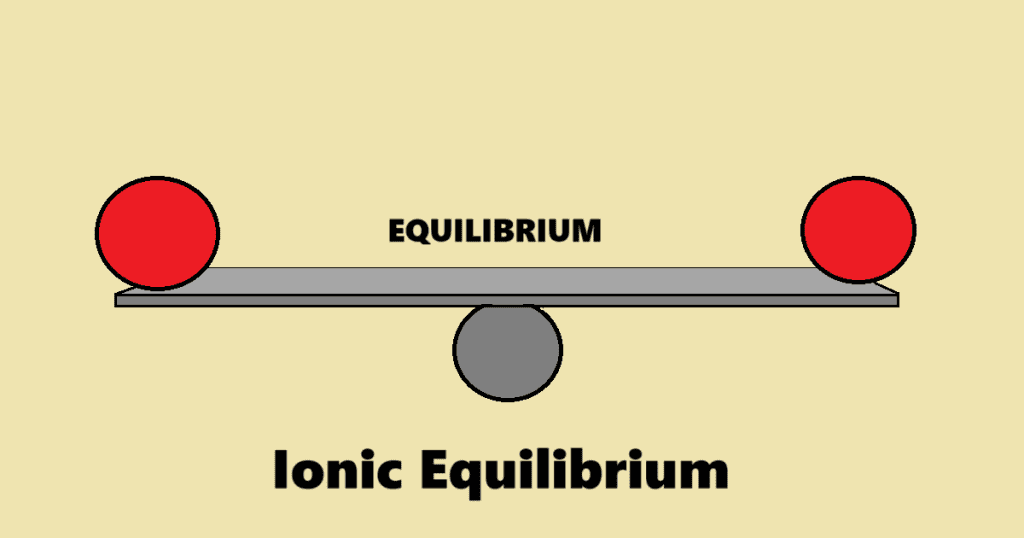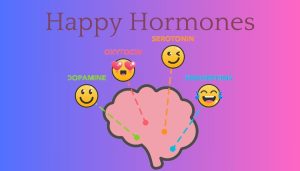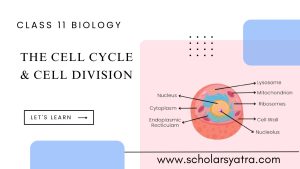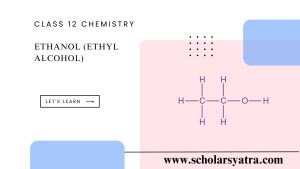Introduction of Ionic equilibrium
Ionic equilibrium refers to the state in a reversible chemical reaction where the rates of the forward and reverse reactions involving ions in an aqueous solution are equal, resulting in no net change in the concentration of the reactants and products.
Table of Contents
ToggleSome Terminologies of Ionic Equilibrium
- Dynamic Nature:
Even though the concentrations of ions remain constant at equilibrium, the reactions continue to occur at the molecular level. This is known as a dynamic equilibrium.
- Equilibrium Constant (K):
The ratio of the concentrations of the products to the reactants, each raised to the power of their coefficients in the balanced equation, remains constant at a given temperature. For ionic reactions, this is often referred to as the ionization constant or dissociation constant.
- Le Chatelier’s Principle:
If a system at equilibrium is disturbed by a change in concentration, temperature, or pressure, the system adjusts to partially counteract the disturbance, and a new equilibrium is established.
- Examples:
Weak Acids and Bases: The ionization of acetic acid (CH₃COOH) in water to form acetate ions (CH₃COO⁻) and hydrogen ions (H⁺).
Saturated Solutions: The dissolution and precipitation of salts like calcium carbonate (CaCO₃) in water.
- pH and pOH:
In aqueous solutions, the equilibrium concentrations of hydrogen ions (H⁺) and hydroxide ions (OH⁻) determine the pH and pOH of the solution, which is crucial for understanding the solution’s acidity or basicity.
- Buffer Solutions:
Solutions that can resist changes in pH upon the addition of small amounts of an acid or a base, typically involving a weak acid and its conjugate base or a weak base and its conjugate acid, rely on ionic equilibrium.
Ionic Equilibrium Theory
Michael Faraday classified substances into two types based on the conduction of electricity.
- Electrolytes
- Non-Electrolytes
Electrolytes
Substances that conduct electricity in its molten state or solution form (aqueous medium) are known as electrolytes. An ionic compound is known as an electrolyte. Ionic compounds and very polar covalent compounds are electrolytes. Acids, Bases, and Salts are the examples of electrolytes. Electrolyte conducts electricity due to the formation of ions produced by disassociation of a substance.
Non-electrolytes
Non-electrolytes are known as substances that do not conduct electricity in their molten state or solution form (aqueous medium). Non-polar covalent compounds are non-electrolytes. Sugar, glucose, benzene, glycerin, etc. are examples of non-electrolytes.
Based on a state of disassociation (ionization), electrolytes are further classified as:
- Weak electrolytes
- Strong electrolytes
- Strong electrolytes: Electrolytes that ionize almost completely in their solution form are known as strong electrolytes. Examples: NaCl, KOH, H2SO4, HCl, etc.
NaCl (aq.) → Na+ + Cl –
As strong electrolytes ionize to a greater extent, they form more ions and conduct electricity to a greater extent.
2) Weak electrolytes: Electrolytes that ionize to a small extent or ionize incompletely in their solution form are said to be weak electrolytes. For example; H2S, NH4OH, HCN, CH3COOH, etc. Weak electrolytes are feebly ionized and a dynamic equilibrium is established between unionized molecules and ions, this dynamic equilibrium is called ionic equilibrium.
Strong electrolytes and weak electrolytes depend on the nature and strength of the bond between the atoms of the compound.
True/Potential electrolytes
i) True electrolytes are the electrolytes that exist in ionized form in the pure state. For example; ionic compounds.
ii) Potential electrolytes are electrolytes that do not exist in the ionic form in a pure state but produce ions when dissolved in a suitable solvent. For example: very polar organic compounds
Arrhenius’s theory of ionization
A Swedish chemist Svante Arrhenius in 1887 AD, put forward a theory regarding the ionization of electrolytes in a solution called Arrhenius’s theory of ionization.
The main points are:
i) When an electrolyte (acid, base, or salt) is dissolved in water or any polar solvent, it splits into two oppositely charged particles which are known as ions. The positively charged particles are called cations and negatively charged ions are called anions. For a binary electrolyte,
AB → A+ + B –
ii) Ions of an electrolyte can freely move throughout the bulk of the solution.
iii) An electrolytic solution as a whole is neutral i.e. the total number of cations is equal to the total number of anions.
iv) The electrical conductivity of an electrolyte is due to the migration of cation towards the cathode and anion towards the anode.
v) The process of ionization of a weak electrolyte is reversible. Unionized electrolytic molecules are constantly dissociating and formed ions are constantly reuniting. Therefore, an equilibrium is established between unionized molecules and ions. For example:
AB is a weak electrolyte
The equilibrium constant is represented as
ka = [A+] [B−] [AB] [Applying law of mass action]
where ‘ka’ is the dissociation or the ionization constant
vi) The process of ionization of a weak electrolyte is incomplete. Only a fraction of the total number of electrolytic molecules undergo ionization. The fraction of the total number of electrolytic molecules present as free ions is known as the degree of ionization. It is represented by α.
Mathematically,
Degree of ionization (α)=Number of molecules ionized into ions Total number of molecules dissolved
Physical properties like odor, magnetic property, a refractive index of electrolyte are due to the properties of ions present in the electrolytic solution. For example, the CuSO4 solution is blue due to the presence of Cu++ ions.
Limitations of Arrhenius Theory of Ionization
i) Electrolytes ionize and maintain equilibrium not only when dissolved in water but also in the molten state.
ii) This theory is valid only for weak electrolytes.
Factors Affecting Degree of Ionization
The degree of ionization depends on the polarity and strength of the bond and the extent of solvation of ions formed.
i) Nature of electrolyte: The value of a degree of ionization (α) depends on the nature of the electrolyte i.e. bond present on the electrolyte. The value of α for a strong electrolyte (perfectly ionic compound) is almost equal to 1 (α≅1). For a covalent compound, its value is 0, and covalent compounds with ionic character have the value of α between 0 and 1.
ii) Nature of solvent: The value of the degree of ionization for the polar solvent is greater than that for non-polar solvents. It is because the polarity of solvent assists dissociation of electrolytes in solution.
iii) Dilution
According to Ostwald’s dilution law,
α = √kdv, where is dilution
i.e. α ∝ √v
It means to say that on increasing the dilution, the degree of ionization increases. It is found that in an infinite dilution, weak electrolytes ionize almost completely.
iv) Temperature
The degree of ionization depends on the temperature. When temperature increases, the kinetic energy of the molecule also increases which in turn decreases the ionic force of attraction between ions and as a result, more and more ions are formed. Therefore, the higher the temperature, the higher will be the value of α.
v) Common ion effect
The suppression of ionization of weak electrolytes in the presence of strong electrolytes having one ion common to both is known as the common ion effect.
Ostwald’s Dilution Law
According to Arrhenius’s theory of ionization, a dynamic equilibrium exists between unionized and ionized ions. Ostwald noted that the law of mass action can be applied in ionic equilibrium similar to chemical equilibrium.
Limitations of Ostwald’s dilution law
i) Ostwald’s dilution law cannot be used for strong electrolytes. Since,
kd = Cα21−αCα21−α
For strong electrolytes, the value of α is almost equal to 1, and ( 1-α) becomes 0 As a result, kd becomes infinite (undefined).
Thank You!





